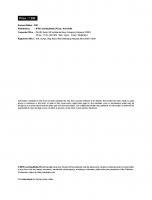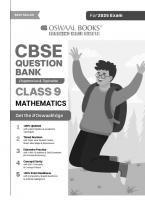Xam idea: Mathematics Class 9 Book, CBSE Bos Included, 2023-24 Exam 9789356122390
143 39 24MB
English Pages [362] Year 2023
Recommend Papers

File loading please wait...
Citation preview
PART–A S
Basic Concepts
S
Selected NCERT Questions
S
Multiple Choice Questions
S
Very Short Answer Questions
S
Short Answer Questions–I
S
Short Answer Questions–II
S
Long Answer Questions
S
Case Study-based Questions
S
Proficiency Exercise
S
Self-Assessment
S
Assertion-Reason Questions
1
Real Numbers
Basic Concepts 1. Natural Numbers (N): The counting numbers 1, 2, 3, ... are called natural numbers. 2. Whole Numbers (W): Natural numbers 1, 2, 3..., etc. together with the number 0 (zero) are called whole numbers. 3. Integers (Z): The set of natural numbers, zero and negative of natural numbers constitute the set of integers. p 4. Rational Number (Q): A number is called a rational number, if it can be written in the form q , where p and q are integers and q ≠ 0. p 5. Irrational Number: A number is called an irrational number, if it cannot be written in the form q , where p and q are integers and q ≠ 0. 6. Real Numbers (R): A collection of rational and irrational numbers. 7. The decimal expansion of a rational number is either terminating or non-terminating repeating (recurring), conversely, a number whose decimal expansion is terminating or non-repeating recurring (repeating) is rational. 8. The decimal expansion of an irrational number is non-terminating non-recurring (non-repeating). Conversely, a number whose decimal expansion is non-terminating non-recurring is irrational. 9. If r is a rational and s is an irrational number then r + s and r – s are irrational numbers and rs and r s are also irrational numbers, r ≠ 0. 10. If a, b are positive real numbers and m, n are rational numbers. Then, am = am – n an 1 (iii) (am)n = amn (iv) a –m = m a a m am (v) ambm = (ab)m (vi) m = c m b b (i) am × an = am+n (ii)
1
(vii) ^ a mh n = ` a n j = a n 1 m
m
i.e.,
n
a m = ^n a h = a n m
m
Real Numbers
a –m b m (viii) c m = b a l b If a and b are positive integers, then 1 (i) Rationalising factor of is a . a 1 (ii) Rationalising factor of is a " b . a! b
3
1 is a! b
(iii) Rationalising factor of
a" b.
11. Let a > 0 be a real number and n be a positive integer. Then symbol used in n a is called the radical sign.
n
a = b if bn = a and b > 0. The
12. There are infinitely many rational numbers between any two given rational numbers. 13. If we add, subtract, multiply or divide two irrationals, the result may be rational or irrational. 14. For positive real numbers a and b ab = a b
a
a = b
b
^ a + b h^ a – b h = a – b
^ a + b h = a + 2 ab + b 2
Selected NCERT Questions
1 . 7– 6
1. Rationalise the denominator of
7+ 6 1 1 = × 7– 6 7– 6 7+ 6 7+ 6 7+ 6 = = 2 2 7–6 ( 7) – ( 6) Sol.
= 7 + 6 2
2. Find: (i) 32 5 2
Sol.
(ii) 125
–
1 3
2
(i) 32 5 = (25) 5 5×
=2 (ii) 125
–
1 3
2 5
= 22 = 4 1
= (53) – 3
= 53 × d – 3 n = 5 –1 = 1 5 1
2
Sol. Xam idea Mathematics–IX
1
1
1
3. Simplify: (i) 2 3 .2 5 (ii) 7 2 .8 2 2 3
1
1
1
2
(i) 2 .2 5 = 2 3
+
1 5
13
= 215 1
1
(ii) 7 2 .8 2 = (7×8) 2 = 56 2 4. Write 4 Sol. 4
4
1 in decimal form and find what kind of decimal expansion it has. 8
1 33 = , 8 8
By long division, we have
4.125 8 33.000 −32
)
10 −8 20 − 16 40 − 40 0 33 = 4.125, which is terminating. 8 1 ∴ 4 has a terminating decimal expansion. 8 5. Find six rational numbers between 3 and 4.
Sol. A rational number between 3 and 4 is 1 (3 + 4) = 7 2 2
i.e.,
3



![Riazi / Mathematics (Class 9) [9]](https://ebin.pub/img/200x200/riazi-mathematics-class-9-9.jpg)


![Oswaal CBSE Chapterwise & Topicwise Question Bank Class 10 Mathematics Standard Book (For 2022-23 Exam) [18 ed.]
9355951531, 9789355951533](https://ebin.pub/img/200x200/oswaal-cbse-chapterwise-amp-topicwise-question-bank-class-10-mathematics-standard-book-for-2022-23-exam-18nbsped-9355951531-9789355951533.jpg)


